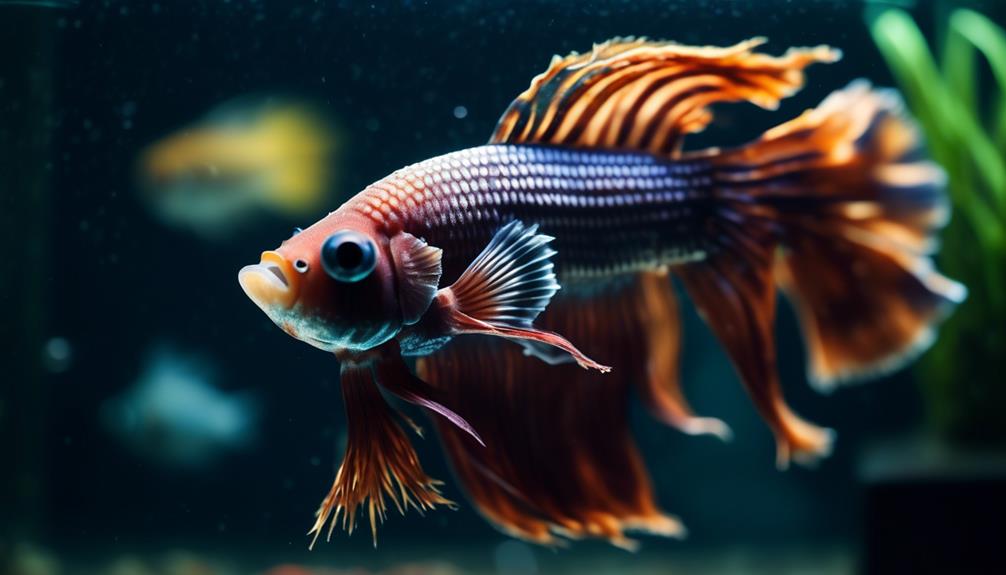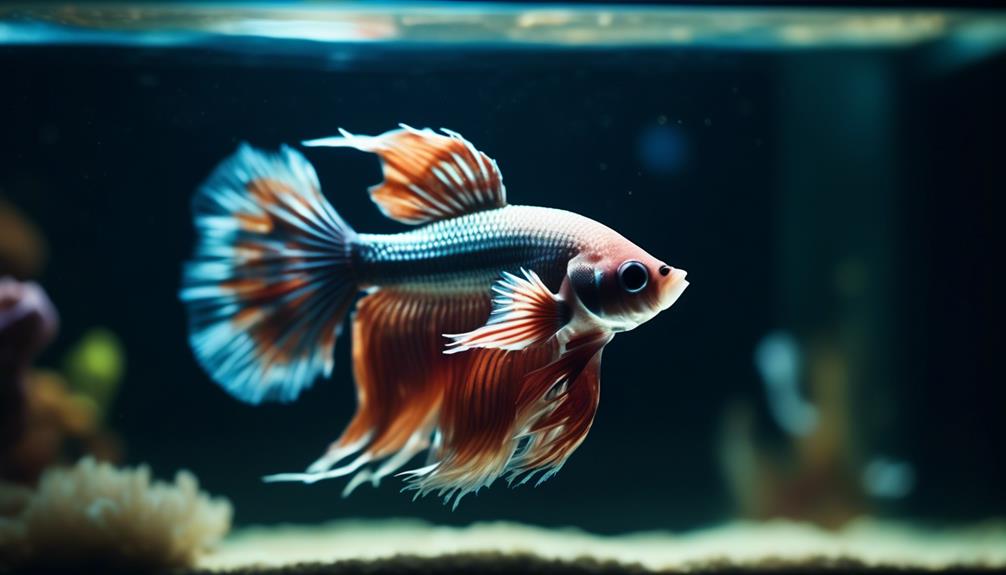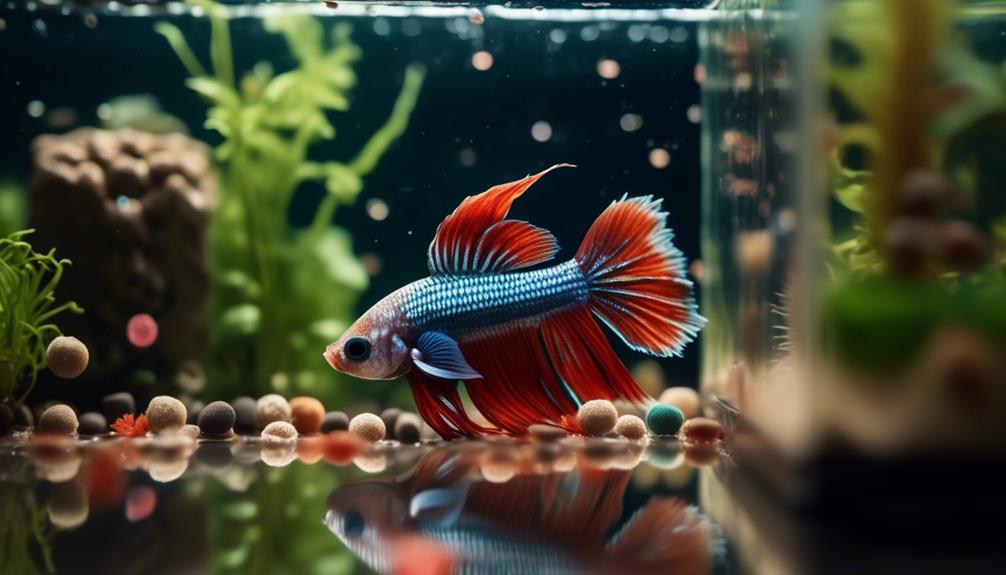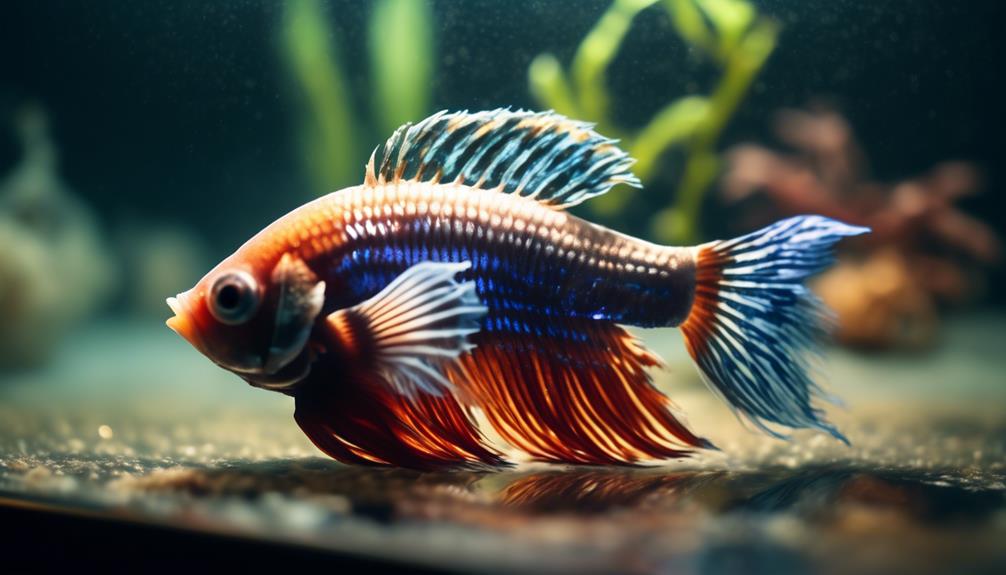I'm an aquarist and I find it calming to watch my betta fish rest on its side. But when it does that, it might mean there's a problem.
I've seen my betta act like this and I know it could be a bad sign. We need to understand why our colorful betta fish lay down like this. Is it tired, just sleeping in a funny way, or could it be sick or in bad water?
We must watch our betta fish and the water they live in to keep them healthy. Stay here, and I'll tell you how to tell if your betta is just resting or needs help.
Key Takeaways
As an aquarist, observing my betta fish occasionally resting on its side is both soothing and concerning. This behavior can indicate potential health issues. It's critical to discern whether a betta is merely sleeping or if it's a sign of illness or poor water conditions. Monitoring the betta fish and their aquatic environment is essential for their well-being. I will discuss how to differentiate between a betta fish that is simply taking a rest and one that may require assistance.
Mike's Thoughts
Betta fish lying on their side can be alarming for owners. While it may be a harmless resting position, it could also signal something more serious. It's important to observe the behavior of your betta and the quality of the water they inhabit to ensure their health.
I've included more detailed information below on this subject, so please continue reading and don't hesitate to leave a comment or contact me on <a href='https://www.facebook.com/groups/aquariumadvice'>Facebook</a> if you have any questions.
Resting Behavior Explained
Sometimes, when you spot your betta fish laying on its side, it's just taking a break, much like we might take a quick nap to recharge. Betta laying at the bottom of the tank or on its side can be pretty normal. These little guys sometimes need to rest, and conserving energy is part of their natural behavior, especially after a hearty meal or a busy day zipping around their tank.
But if you see your betta laying on its side at the bottom often, it might be a sign that something's up. It could be exhaustion, or maybe there's a swim bladder disorder causing negative buoyancy. That's when they can't control their up and down movements in the water, sort of like when you're trying to float on your back but keep tipping over.
The reason your betta is laying down more than usual could be due to the water quality too. Things like high ammonia levels or not enough oxygen can stress them out. To keep your finned friend healthy, make sure their tank's in tip-top shape with regular cleanings and a balanced diet. That way, their resting behavior is just that – a quick snooze to get back to their best.
Common Betta Illnesses

Seeing my betta fish laying on its side made me worried. So, I started learning about common illnesses that might be affecting it.
Two issues I found are swim bladder disorder and fungal infections, which can both cause a betta to lose its balance.
It's important to spot these early on to help our little friends get back to swimming happily.
Swim Bladder Disorder
Swim bladder disorder is a common ailment that can cause a betta fish to lose its ability to swim properly and end up lying on its side. When your betta is affected by this, it's heartbreaking to see them struggle.
Here's what I've learned about this disorder:
- Causes:
- *Poor water quality*: A dirty tank can lead to health issues.
- *Infections or genetics*: Sometimes the cause of swim bladder problems is out of our control.
- Symptoms:
- *Laying on the bottom*: Your betta fish mightn't be able to maintain buoyancy.
- *Swim sideways*: It's sad to see them unable to swim normally.
- Treatments:
- *Tank adjustments*: Cleaner water and suitable flow can make a big difference.
Fungal Infections
While swim bladder disorder is a distressing condition, it's not the only issue that can afflict betta fish; fungal infections are another common ailment to watch out for. If you notice white spots that look like cotton on your betta's body, it could be a sign of a fungal infection. Poor water conditions often lead to such problems, stressing the fish and compromising its immune system.
To keep your betta fish tank healthy, it's crucial to maintain high water quality with regular water changes. This helps prevent the growth of fungi like Saprolegnia, which can cause cotton wool disease. If your betta does get sick, don't fret—antifungal meds or aquarium salt can usually clear things up. Remember, a clean tank means a happy and healthy betta!
Tank Conditions and Maintenance
To ensure your betta fish remains healthy and vibrant, maintaining optimal tank conditions is a must. Here's what I've learned about creating a cozy home for these little swimmers:
- Tank Size and Setup:
- Minimum 5 gallons: Gives them enough space to explore.
- Calm waters: Bettas aren't fans of strong currents.
- Cozy hideouts and plants: They love to have their little nooks and greenery to feel secure.
Managing water quality is a big deal for the wellbeing of my betta. I keep an eye on these factors:
- Water Quality and Maintenance:
- Frequent water changes: About 20% weekly keeps the water fresh.
- Ammonia levels: Should always be at 0 ppm to avoid toxicity.
- Beneficial bacteria: They're the unsung heroes that balance my tank's ecosystem.
I also focus on the nitty-gritty:
- Water Parameters and Care:
- Water temperature: Keeping it a cozy 78-80°F is ideal.
- pH levels: Aiming for 6.5-7.0 helps prevent stress.
- Water conditioner: It's a must when adding fresh water to remove harmful chemicals.
Regular cleaning of the tank, alongside monitoring water flow, ensures my betta fish can swim happily and healthily. It's all about creating a stable and loving environment for my finned friend!
Ammonia Poisoning Symptoms

Recognizing the signs of ammonia poisoning in betta fish is crucial for their well-being. Symptoms include lethargy, loss of appetite, and abnormal swimming behavior like laying on the side. It's heartbreaking to see if your betta fish is lying at the bottom of the tank or struggling to swim properly.
Increased ammonia levels in the tank are a common cause of these issues. Poor water quality can sneak up on you, and before you know it, your beloved pet could be suffering. Ammonia, which should be at 0 ppm (parts per million) for a healthy environment, can quickly rise due to factors like overfeeding or inadequate filtration.
If your fish is gasping at the water's surface or showing signs of discoloration and faded colors, it's time to test the water. Inflamed or reddened gills are also clear symptoms of ammonia poisoning. And let's not overlook fin rot, which can sometimes accompany these symptoms if the water's been bad for a while.
Treating ammonia poisoning starts with improving your tank's conditions. Regular water changes and monitoring the ammonia levels are key. Remember, prevention is the best cure, so keep an eye on your water quality to keep your betta happy and healthy.
Diagnosing Betta Health Issues

I'll start by saying that pinpointing the exact health issue your betta fish is facing can be tricky, but careful observation and knowledge of common ailments will guide you through the process. When my betta started laying on its side, I knew something was off. Here's what I've learned about diagnosing a sick betta:
- Check to See If It's Swim Bladder Disease
- The swim bladder is an organ that helps bettas maintain buoyancy.
- Fish laying on side might struggle to swim upright or float unnaturally.
- Overfeeding or constipation often leads to swim bladder problems.
- Look for Signs of Fungal or Bacterial Infections
- Fuzzy patches or sores? Could be a fungal or bacterial issue.
- If the water's dirty or if your betta's injured, infections are more likely.
- Consider Other Common Diseases
- Fin rot or velvet can also cause distress.
- A healthy betta usually has vibrant colors and fins; dullness or fraying could spell trouble.
Treatment Options Available

When I noticed my betta fish lying on its side, I knew I needed to look into treatment options.
First off, I'll make sure the water conditions are pristine because that's often the root of the problem.
If that doesn't help, it's time to consider medical treatments to get my little buddy swimming right again.
Adjusting Water Conditions
To help a betta fish that's lying on its side, you must first ensure the water conditions in their tank are optimal. Adjusting water conditions can be a game-changer for your betta's health. Here's what I focus on:
- Water Conditions:
- Regularly test the aquarium water to keep ammonia, nitrites, and nitrates at safe levels.
- Maintain the water temperature around 78 degrees Fahrenheit for those delicate, flowing fins.
- Use water conditioners to remove harmful chemicals and improve water quality.
- Epsom Salt:
- Can be used occasionally to reduce swelling and aid buoyancy issues.
- Water Volume:
- Perform partial water changes to keep things fresh, but be careful to reduce the water flow—bettas aren't fans of strong currents.
Good quality water means a happier and more vibrant betta fish!
Medical Interventions Needed
After ensuring the water quality is up to par, it's crucial to explore the medical interventions available for a betta fish that's laying on its side. When my betta is laying at the bottom of the tank, it could be a swim bladder issue. Disease causes like this need specific treatments, so I'd consult a vet experienced with fish. They might suggest moving my fish to a quarantine tank and starting medication.
For bacterial infections, especially gram positive types, antibiotics like Ampicillin are often recommended. Precise diagnosis is key to determining the right course of action. Sticking to the vet's advice and carefully dosing any meds, I'd keep a close eye on my betta, hoping for improvement and ensuring it doesn't lay at the bottom anymore.
Diet and Nutrition Factors

Ensuring your betta fish enjoys a balanced diet plays a crucial role in preventing them from developing health issues that could leave them listlessly lying on their side. I've learned that diet and nutrition factors can significantly impact their well-being, from the risk of swim bladder problems to the dreaded fin rot.
Here's what I focus on to give my fish the best chance at a healthy life:
- High-Quality Food
- Betta-specific pellets: They're packed with the good stuff bettas need.
- Occasional live food: Bloodworms and brine shrimp make for a tasty treat and encourage natural hunting behaviors.
- Fasting days: I skip feeding once a week to help their digestive system reset.
- Portion Control
- Since food can expand in a fish's stomach, I'm careful not to overfeed. Just a few pellets per meal are enough.
- Good Nutrition
- Protein is key: It helps my betta fish thrive and supports their immune system.
- A little fiber: I occasionally include fiber-rich options to aid in digestion and prevent constipation.
Environmental Stressors

While a balanced diet is fundamental for my betta's health, I've also found that minimizing environmental stressors is just as important to keep them from lying listlessly on their side. When my betta tank isn't quite right, I can tell because my little buddy doesn't swim around with the same gusto. A strong water current, for example, can be too much for them, making it hard to navigate their home.
I've learned that keeping the water in their tank clean and stable makes life much easier for them. It's crucial to monitor my water tank's pH levels and keep an eye out for ammonia spikes, which are big no-nos for my betta's health. Also, tank mates can be a hidden source of stress—if they're too aggressive, my betta might just retreat to the bottom of the tank to avoid conflict.
I've found that upgrading to a larger tank when possible helps dilute toxins like nitrates and gives my betta more space to thrive. Regular maintenance and water changes are a must to prevent these environmental stressors from affecting my betta. It's all about creating a serene and safe space for my little friend to flourish.
Preventative Care Strategies

To keep my betta swimming happily, I've adopted several preventative care strategies that safeguard its well-being. Here's what I focus on to ensure a healthy environment for my finned friend:
- Maintain Proper Tank Conditions
- A cycled tank is a must, and I always aim for at least one gallon of water for my betta fish. They need space and clean water to thrive.
- I keep a close eye on the temperature and pH, making sure they stay at a cozy 78-80°F and a neutral 6.5-7.0.
- Regular Water Quality Management
- I'm diligent with water changes, doing them regularly to keep the conditions in the freshwater aquarium pristine.
- Using a water conditioner is key to neutralize chlorine and keep heavy metals at low concentrations.
- Balanced Diet and Feeding Routine
- Betta fish need a good mix of protein and fiber, so I choose high-quality betta food and watch those portion sizes—no overfeeding here!
- I stick to a feeding routine, but I also throw in the occasional fasting day to keep things in check.
I've learned that hardy fish or not, a quarantine tank for new fish can prevent a lot of trouble in the regular tank. These preventative care strategies have made a world of difference!
Frequently Asked Questions
Why Is My Betta Fish Laying on Its Side?
I'm worried because my fish isn't swimming right. It could be stress, poor water quality, small tank, bad diet, sickness, temperature changes, old age, sharp decor, filter problems, or ammonia poisoning.
Why Is My Betta Fish Floating on the Side but Not Dead?
I've noticed my betta floating sideways but it's not dead. This may be due to stress, poor water quality, or temperature changes. Ensuring proper tank size, filtration, and nutrition is crucial for its health.
How Do You Treat Swim Bladder Disease in Bettas?
To treat swim bladder disease in bettas, I focus on water quality, use the fasting method, and make dietary adjustments. Gradual acclimation, temperature regulation, stress reduction, and antibiotic treatment may also be necessary.
Why Is My Fish on Its Side but Still Breathing?
I'm noticing my fish is lying on its side yet still breathing. It could be stress, poor water quality, or even temperature shock affecting it. I'll check for ammonia, nitrate, and pH levels.